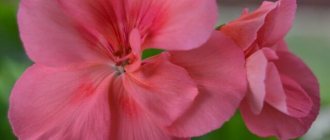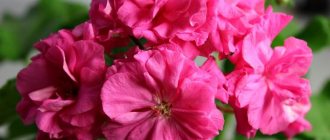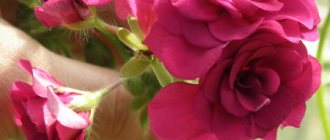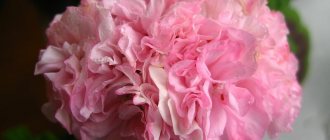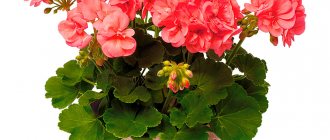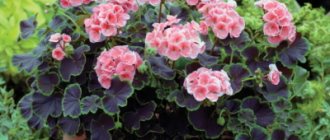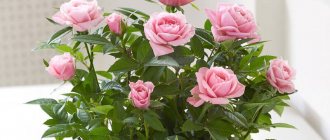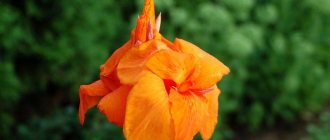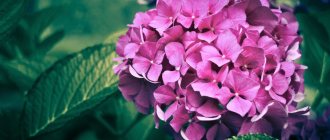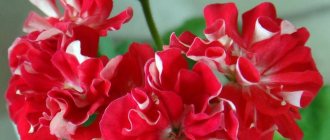In this article we will talk about one of our favorite indoor plants, which is pelargonium ivy. This group of indoor and garden geraniums is not yet very widespread among our gardeners.
Let's take a closer look at this beautiful flower, and start with its origin.
The homeland, like all other types of pelargonium, is South Africa, Cape Province. This beauty appeared in Europe in the early 1700s, of course, first in Holland, and later came to England and France.
Features of the view
Despite its hot homeland, ivy-leaved geranium (more precisely, its hybrids - varieties and varieties bred by numerous breeders) grows successfully on all continents. The crop is especially popular among gardeners: it is planted along vertical slopes, allowing the vines to hang beautifully; grown in hanging pots or simply allowed to unravel on a flat surface. Ivy-leaved pelargonium got its name from the shape and color of the foliage: the leaves are smooth, leathery, and five-lobed.
The shoots of this geranium are quite powerful; they are able to “cling” to protrusions on vertical surfaces, rising upward and scattering seeds around. In most varieties of ivy geranium, shoots grow up to 1 m long. The plant is characterized by umbrella inflorescences of 10–15 flowers each.
Varieties and photos
The classification distinguishes 6 main types. All the rest of the rich variety of varieties are bred from these main species. Below are photos, names and descriptions of pelargonium varieties suitable for propagation and care at home:
Ivy-leaved
Ivy-leaved pelargonium. Better known as ampelous. It earned its name for its flowing flexible side branches, which can reach a length of 1 meter. The leaves are smooth to the touch, which makes them different from other species whose leaves are covered with hairs.
This species is grown indoors, but in the warm season it is perfect for decorating open balconies and gardens.
Loves warmth and light very much .
Abundant watering and lighting will have a beneficial effect on the growth and flowering of the plant. Ivy-leaved pelargonium does not like transplanting. After transplantation, a dormant period begins, during which there is no flowering or very little flowering. It is recommended to plant this species in 2 seedlings, in flower boxes 60 cm long, in which they can grow without transplanting for at least 3-4 years. The following varieties are distinguished:
- Kristal queen F1 rose
- Kristal queen F1 white (Kristal Queen F1 White)
- Kristal queen F1 red (Kristal Queen F1 Red) the listed selection varieties have a powerful bush with long hard branches and leaves. Resistant to winds and bad weather. Guaranteed abundant flowering throughout the season.
- Summer Waterfall F1 is a selection variety. With good care, it will delight you with colorful flowering from June to September.
- Cascade of color F1 - selective hanging is perfect for vertical gardening.
In the photo below is the Pelargonium Ivy-leaved variety:
Royal
Royal pelargonium. It has a faint floral aroma . A 50-centimeter plant is considered medium-sized. Flowers of various colors in inflorescences are at least 15 cm in diameter. Looks great both on the windowsill and in the summer version of landscape design in the garden. This species does not like frequent replanting, so it is better to use a flower in a pot when decorating the garden.
In winter, flower care is reduced to ensuring a temperature regime of no higher than 10-15°C.
There are more than 1000 varieties and the selection of new ones continues. The most famous of them:
- Candy flowers (Candy Flowers) large-flowered, low-growing. Flowers up to 4 cm in diameter. Plant height 20 cm.
- Candy flowers Violet (Candy Flowers Violet) two-color large flowers will not leave anyone indifferent. The purple color gradually turns into red.
- Bright red (Bright Red) forms a compact bush and dark red flowers, gradually turning into a burgundy shade.
- Camred (camred). A small bush with bright red flowers. The leaves are dark green and form a thick green mass.
- Grandiflora is a wonderful decorative variety of royal pelargonium. Flower connoisseurs distinguish it from other varieties for its large, lush inflorescences, reaching a diameter of 20 cm.
The photo below shows Royal Pelargonium:
Zonal
Zonal pelargonium. The species received this name because of the ring-shaped spot on the leaf, which is called a zone. This species has an upright bush and small flowers in an inflorescence. The leaves are covered with fluff. The branches are straight, depending on the variety, the length ranges from 10 to 50 cm .
Zonal pelargoniums are the most common due to their unpretentiousness. Breeders have developed more than 40 thousand varieties, and this number increases every year. The most common: rose-shaped (double), tulip-shaped, carnation-shaped, star-shaped, cactus-shaped, “deacon”.
Tulip-shaped
Tulip pelargonium. The flowers of this species look like small, unopened tulip flowers. The leaves of the bush are hard and smooth, rich green in color.
In total, there are about 20 varieties of tulip-shaped pelargonium, among which there are dwarf species up to 30 cm tall and tall ones up to 80 cm. But regardless of the type and growth of the plant,
the bud does not exceed 1 cm in length .
The flower is very beautiful and unusual. Moreover, it does not require any special care. Widely popular both among experts and among beginners in floriculture. The only maintenance requirements are diffused sunlight in summer and additional lighting in winter.
The most popular tulip varieties: Happy Birthday, Mrs. Charles, Marie-Louise, Marbacka Tulpan, Viktoria Andrea, Carmen Andrea, Patricia Andrea, Pink Pandora, Conny, Helma. You can see what the Pelargonium Tulip-shaped variety looks like in the photo below:
Rosaceae
Rosaceous (double) varieties. They can also be found under the name “rosebud pelargoniums”. In appearance, the flowers resemble roses . Because of their decorative effect, they are very popular among flower growers.
Rosebuds look spectacular on a windowsill, balcony or in the garden. Small bushes and large inflorescences make this species stand out from the crowd. In total, there are more than 22 varieties of this variety. Among the most famous are: Denis, Highfields Sugar Candy, April Snow, Norrland, Scarlet Rambler and many others.
Dianthus
Carnation pelargonium gets its name from its flowers, whose jagged edges make them look like carnation flowers. The following varieties are known among connoisseurs: Diana Palmer, Freshwater, Pat Hannam, Graffiti Violet.
Star-shaped
Star pelargonium is so called because both the leaves and flower petals have an angular shape. And they look like stars. The following varieties of this species are noted: Lotta Lundberg, Pink, Golden, Joann, Bob Newing, Little Linda.
cactus-shaped
Cactus pelargonium, according to tradition, received its name because of the shape of the flowers, the twisted petals of which resemble cactus flowers. The most striking representative of the subgroup is Mallorca. The striped, unusual coloring of large flowers on a high peduncle made this variety the most beloved among connoisseurs. Also distinguished are Mrs. Salter Bevis, which perfectly forms into a voluminous bush with fluffy inflorescences.
Deacon
Pelargonium Deacon (deacon) appeared as a result of crossing zonal and ivy. The name of the species was given by the profession of the English priest who bred this species. It is distinguished by its small growth and large flowers. The most famous include: Arlon, Flamingo, Summertime, Clarion, Sultan, Moonlight, Gala.
Quantum F1
Quantum F1 hybrid variety. Still little known among flower growers. It differs from other varieties of zonal pelargonium in that it forms not 2-3 peduncles, but 6-8 simultaneously blooming inflorescences.
Tuscany
Tuscany (Toscana), a dwarf zonal variety. It belongs to the industrial varieties, thanks to which it is not picky about the conditions; the bush forms itself.
Rafaella
Rafaella F1 is a new type of perennial bred by breeders. Highly valued by flower growers for its aesthetic appearance. The bush grows up to 40 cm, and the inflorescences reach 15 cm in diameter.
Scarlet
Scarlet F1 is a hybrid variety of zonal pelargonium. The leaves are dark green with a brown ring. Flowers in voluminous inflorescences of scarlet or red color.
Fragrant
Fragrant pelargonium. All types of this plant have no aesthetic value. The appearance is not presentable: the bushes are loose, up to 1 m in height, the small flowers are mostly white, sometimes pink. Fans of these varieties grow them for their fragrant leaves and flowers. The range of aromas is very wide: peach, pineapple, lemon, mint, apple, verbena, wormwood, oriental spices, pine needles or rose. Flower growers distinguish the following fragrant varieties:
- Fruity – the smell of the leaves has a fruity aroma.
- Candy Dancer has a rose and lemon scent. The leaves are carved, which is very unusual for pelargoniums.
- Clorinda. The leaves have a pine scent.
- Lady Plymouth has a menthol scent.
- Sarah Jane smells like citrus.
Angel
Angel (Angel). This species was bred by an English breeder by crossing curly and royal pelargonium. "Angels" hanging varieties . The bushes have small leaves and flowers up to 1-2 cm in diameter. The flowers are similar to “Pansies”; in almost all varieties of “Angels” they are two-colored with veins. All “Angels” are hybrids bred within the group itself. They are distinguished by their endurance and tolerance to drought. Among the subgroups noted: Androcles, Caravan, Darkness, Debbie, Fairy Queen.
Unique
Unique. A completely unique species, the origin of which is not fully understood. It is believed that this species was obtained by crossing the royal and brilliant. You can distinguish them from other species by the appearance of their leaves; they have a dissected shape. The leaves have a fairly strong aroma, which makes this species similar to fragrant pelargoniums. The bushes are straight, tall, at least 50 cm. The most famous:
- Purple unique - develops into a low bush with purple-pink flowers. In the middle of the flower the color is more saturated.
- Unique Aurore - red inflorescences in the middle with black veins.
- White Unique is one of the old varieties. Pale pink flowers have a darkening of a bright shade in the middle.
- Crimson Unique. Orange-scarlet flowers with dark spots in the center.
The best varieties
Ivy-leaved pelargonium has many varieties and varieties. However, the most popular types are as follows:
- Pelargonium Jackie. Loved by flower growers for its delicate white and pink flowers. Jackie is a new variety, but has already gained great popularity;
- Ivy-leaved ampelous pelargonium Crystal Queen F1 Rose. A hybrid variety characterized by several shades of pink; ampelous ivy-leaved pelargonium Paisley red with bright red inflorescences;
- Jackie Gould. Another popular variety that branches well and blooms profusely;
- Pelargonium Chiffon. Compact bush with large inflorescences of pale lilac color;
- Blanche Rocher. German variety with abundant flowering and white flowers;
- pelargonium variety Pak Red Sybil. It blooms with red inflorescences, shaped like a classic rose. Pak Red Sybil blooms magnificently and for a long time, the inflorescences are large, double;
- Pak Tommy. An old, classic variety with dark purple flowers.
Description
This type of pelargonium (Pelargonium peltatum) is also called p. ivy, p. thyroid, p. English.
Its main difference from other types of pelargonium is that it is a hanging plant. In its homeland, this geranium is a subshrub with long creeping shoots (up to 90 cm long). Its leaves are quite hard, fleshy and shaped like ivy leaves - hence the name.
Flowers (usually 1.5-2.5 cm in diameter) sit on long peduncles, are simple and double, collected in inflorescences, in nature white and pink.
P. ivy is grown as a houseplant, on balconies and loggias, but it is especially good in the garden in hanging pots and tall containers. Its long branches branch very densely, the plant grows luxuriantly and blooms profusely - literally turns into a bright blooming ball.
Secrets of cultivation
Like most herbaceous plants, the culture prefers open, sunny places and long daylight hours. Easily tolerates short-term drought, prefers temperatures at +20...+25 °C. The plant can tolerate short-term moderate cold snaps, but if the temperature drops to sub-zero values, it dies. The soil should be nutritious, loose, and retain moisture well. Be careful not to overwater the plant, otherwise the roots may be damaged.
During the period of active development of the crop, it needs to be fed. This time falls on the period from March to September. But you should not get carried away with nutrient mixtures that contain nitrogen: everyone knows that an excess of this element leads to rapid development of the green mass of the plant. At the end of flowering, the bush should be subjected to sanitary formative pruning and sent for wintering. By the way, the cuttings that remain after pruning are perfect for propagating the crop.
Care
Pelargonium is undemanding to conditions and care at home, which is why it is widespread everywhere. Amateur and professional flower growers appreciate it for these qualities. But there are still some nuances in agricultural technology that should be observed in order for the cultivation of this flower to be fruitful.
Lighting
All varieties love sunlight very much, but you should avoid direct contact with the plant . Otherwise, the flower may get burned, which will have a bad effect on its condition. Zonal pelargoniums are more adaptable in this regard, since they can grow in open ground. Therefore, they are used to enliven the borders of garden paths, in flower beds, both single plantings and in compositions.
But many hybrids grown only as potted plants are not only sensitive to direct sunlight, but also require additional lighting in winter.
Temperature
For adult plants it is not important.
Pelargoniums in landscape design feel great at +18°C. They can easily withstand temperatures up to +40°, subject to regular watering. Some varieties can overwinter in open ground. Indoor specimens, for the most part, also love warmth. But it is recommended to send them to winter rest, at least for a couple of months at an air temperature no higher than +10 °C.
Humidity and watering
Loves abundant watering, but does not tolerate stagnant moisture. It is not recommended to overdry the earthen ball in a flower pot. The same watering requirements apply to garden pelargoniums. Particular attention is paid to regular watering of plants during the hot season. In summer, plants are watered at least 2 times a week ; in winter, once every 7-10 days is sufficient.
What to feed?
Pelargonium is responsive to care. But applying too much fertilizer or using it too often can have the opposite effect. Instead of a friendly flowering, the plant can use its energy to increase green mass. The main components of fertilizer are phosphorus and potassium.
To avoid problems with calculating the amount of solution to be applied, it is recommended to use professional mixtures, which can be purchased at any flower shop.
For home remedies, it is best to use iodine, at the rate of 1 drop per 1 liter of water. You will need to add no more than 50 ml of solution to the flower pot. There is also a certain technique for adding iodine solution. Under no circumstances should the solution be poured near the stem; it must be poured along the walls of the pot, strictly after regular watering. Using an iodine solution or a mixture of fertilizers will ensure abundant and rich flowering.
After pruning the plant,
you need to apply nitrogen-containing fertilizers .
Or add a small amount of yeast to the soil. This type of feeding is also good when planting young cuttings in a pot or soil. Yeast solution is prepared from 20 grams of dry yeast and 1 liter of water. Leave for several hours, then dilute with another 5 liters of water. Water the plants with this solution once every 7-10 days. No more than 3 times.
The method of feeding pelargoniums with milk is also popular. For this solution, it is enough to take 100 ml of milk and dilute them in 1 liter of water. Boric acid or succinic acid is also used. Excellent results are shown by using banana peels, which are dried and added in crushed form to the top layer of soil.
Transfer
It is not recommended to transplant too often. Undemanding to soil and space. To achieve lush and long-lasting flowering, you need a pot that is not too loose , it is better if it is a little tight. But the earthen lump should not be entirely fertile. In such conditions it blooms profusely and for a long time.
In one place, without transplantation, it feels great for 3-4 years.
After transplanting into a more spacious pot with fresh fertile soil, pelargonium begins to actively develop the unoccupied territory. Therefore, it expands the root system and, as a result, the green mass of the bush develops, and flowering becomes scarce. But in less than six months it will again begin to devote more energy to flowering.
Priming
Soil mixtures of neutral acidity with good air permeability are best suited for pelargonium.
It is desirable to have sand and peat in the soil so that the composition is light. This is especially important for young plants with a still weak root system. You need to place drainage at the bottom of the flower pot to avoid stagnation of moisture, which can lead to rotting of the roots. For drainage, it is best to use expanded clay, perlite, crushed stone, and small clay fragments.
Pot
It can be plastic, clay, ceramic, bamboo. It is recommended to choose pots that are low but wide in diameter, and plant 2-3 pelargonium bushes in one pot.
Trimming
Pruning is done once a year: in spring or autumn. This operation is carried out in order to rejuvenate the plant and achieve lush flowering in the season. Cut the flower completely, leaving small stumps no more than 5 cm high.
Flower growers recommend autumn pruning so that by the spring awakening, pelargonium has already grown green branches and can devote all its energy to flowering.
Cosmetic pruning is also carried out in order to give the bush a beautiful, symmetrical shape. In this case, only excess branches are removed. The plant is pinched to form a bush. If the flower is not too fluffy , it is worth removing the tops on the branches, this operation will awaken the side buds and the plant will begin to develop in width rather than in length.
Reproduction and transplantation
Geranium can be propagated in two traditional ways: seeds and cuttings.
The second method is used more often, it gives visible results faster, rooting in the soil is not difficult. In addition, you do not have to throw away the branches after pruning. Before rooting the cuttings, be sure to treat them with crushed coal and dry them, which will disinfect the sprouts. There is no need to take special care of geraniums during the rooting period - in about 30 days you will get full-fledged bushes. Geraniums need to be replanted in pots selected according to size: the container should be slightly larger than the previous one, otherwise the root system will not have time to master the earthen ball.
Reproduction
Seeds
Pelargonium seeds can be purchased at a specialty store.
Sowing of seeds is carried out from January to April. The seeds are sown in small pots in light, loose soil, sprinkled with no more than 5 mm of soil, moistened and placed in a warm place. The seeds begin to germinate in about 10 days. You need to water the seedlings carefully - the main thing is not to overwater the young plants.
When 3 true leaves are formed, the seedlings dive into separate cups.
Young geraniums begin to grow quickly, so after a month they can be fed regularly - it is best to use small doses of complex mineral fertilizer with the addition of microelements.
Disease and pest control
Given the specific conditions of maintenance, geraniums cannot avoid sharp fluctuations in humidity and temperature. The most common diseases of pelargonium are fungal infection, chlorosis and viral mosaic. Plants affected by diseases must be treated with appropriate preparations, and the intensity and schedule of watering are adjusted. Most likely, no additional treatment will be required, and your beauty will recover quickly.
If we talk about pests, aphids and spider mites are most often found on the branches of the crop. Considering that insects reproduce rapidly, measures need to be taken as soon as possible. The drug "Aktara" will help to overcome aphids, and "Ditox" copes well with mites.
Botanical description
Pelargonium is an indoor, flowering plant. Directly belongs to the geranium family . Among the perennial and annual herbaceous species, there are subshrubs. Dwarf species are about 20 cm in height, medium - 60 cm, tall - 80 cm.
The stems are branched, creeping or straight. Simple leaves have a palmate or palmately dissected appearance. The leaves are a rich, bright green color and have a pleasant scent.
The flowers, collected in umbrella-shaped inflorescences, have a wide range of colors.
How is pelargonium different from geranium?
Pelargonium is mistakenly called geranium. And although they are very similar in appearance, there are still differences:
- Pelargonium does not have flowers in blue shades, and geranium does not bloom with bright scarlet flowers;
- geranium flower petals are the same, but pelargonium has 2 upper petals that differ from the 3 lower ones;
- geranium is a frost-resistant plant and feels great in garden plots, and pelargonium is heat-loving and can only grow indoors.
Chiffon
Chiffon is an ivy-leaved pelargonium.
Compact, pale pink-lilac flowers with very delicate petals, densely double, pink-shaped.
ATTENTION!
Sending by train is possible to all cities if there is a direct connection from Tyumen to your city!
Year-round delivery of orders to the following cities:
Astrakhan, Baku, Vladivostok, Vladimir, Volgograd, Vyazma, Yekaterinburg, Irkutsk, Ishim, Kazan, Kamensk-Uralsky, Kemerovo, Kirov, Krasnoyarsk, Makhachkala, Megion, Miass, Minsk, Moscow, Nizhnevartovsk, Nizhny Novgorod, Novosibirsk, Omsk, Penza , Pervouralsk, Perm, Rostov, Samara, St. Petersburg, Saratov, Smolensk, Sochi, Surgut, Syzran, Tobolsk, Tomsk, Ulan-Ude, Ulyanovsk, Ufa, Khabarovsk, Chapaevsk, Chelyabinsk, Chita.
Pelargonium varieties
Pelargoniums attract with their unpretentiousness, growth rate and hundreds of different beautiful varieties. These are mainly indoor flowers, but in summer they are often planted in flower beds.
Classification The following species are usually grown from varietal pelargoniums:
Among collectors there are the newest groups, bred on the basis of zonal varieties, which number up to 75 thousand varieties:
- delightful rose-shaped pelargoniums or rosebuds;
- original pelargoniums stellar or star-shaped;
- cactus-like;
- tulip;
- Formosa;
- deacons (deacons).
Flowers are also distinguished by the number of petals (simple, semi-double, double) and the height of the bush (regular and dwarf).
Pelargoniums attract with their unpretentiousness
TOP 10 popular varieties of pelargonium
- A charming 2-color variety Candy Flowers Bicolor (Cambi) with soft pink petals with a bright crimson island in the center. This early flowering series was created in Germany by Elsner Pac based on the Grandiflora pelargonium. Unlike luxurious large-flowered geraniums, which need to be provided with a cool winter without watering for 2 months, the Candy group continues to bloom in winter in heated apartments at temperatures up to 25°C. In summer, flowers are placed in fresh air in pots under cover from rain and wind. Watering is systematic, in hot weather up to 2 times a day.
- The Happy appleblossom variety, like most other zonal rose-shaped plants, has a stem that grows up to 25 cm. It is recommended to grow rosebuds in wide pots, but not deep ones.
- Pelargonium varieties Viva Madeleine (Viva Madeleine) and its other “friends” from the PAK company are distinguished by their stockiness, abundant branching, and long-term flowering of large “roses” on strong peduncles. Pelargonium Pac Viva Madeleine is valued for its delicate and abundant flowering on a neat bush.
- The PAK Salmon queen variety has luxurious and dense inflorescences. Representatives of the series winter well in a warm, bright room - up to 25 °C. In spring, the compact bush of pelargonium Pac Salmon Queen is transformed, almost completely covered with inflorescences of exquisite royal color: white petals with a delicate salmon center.
- Tulip-shaped Emma pleases gardeners with its delicate peach-pink color and graceful flower shape. Emma, according to collectors, is very capricious, although people fall in love with her at first sight.
- The Kronprincesse Mary variety has impressive snow-white tiaras up to 10 cm. Crown Princess Mary is a pink pelargonium, collection 2006, with tight inflorescences on a dwarf bush. With comprehensive fertilizing and constantly slightly moist soil, the flower will decorate a sunny flowerbed until autumn. After pinching, the Kronprinsesse Mary pelargonium bush takes the given shape well.
- One of the beauties of the American dwarf series of recent years is Bold Ann. The variety is low, blooms profusely in shades of a mixture of pink, salmon and white. Bold Ann shoots flower stalks to the sides, forming a rounded silhouette of the bush.
- Star Vectis snow flaunts graceful snowy inflorescences with a greenish center on slender peduncles. The dwarf variety has light green five-fingered leaves with a darker zone along the edges.
- Dove Point inflorescences are distinguished by edged petals. In some varieties, exposure to sunlight causes a slight change in the color of the petals. Dovepoint's voluminous hats turn from white to pink. Therefore, it is better not to place the pots in the sun. Pelargonium Dovepoint touches with dense large inflorescences on low peduncles.
- The light pink Star of the Moscow Region of domestic selection is attractive with its simple elegant flowers. The hybrid is resistant to weather changes, created for growing in flower beds in central Russia. Rises up to 30-40 cm.
Additional Information. Pelargoniums are planted in small pots so that the plants do not fatten, growing green mass, but produce flower stalks.
Candy Flowers Bicolor (Cambi)
Luxurious royal pelargoniums
Keen flower growers tend to the royal, or Grandiflora, pelargoniums, with huge, colorful flowers that give rise to the appearance of miniature Angels. The flowers of royal geraniums are up to 5 cm in diameter and resemble petunias.
Rosebuds
Among double rosebuds, the group with delicately colored petals Happy appleblossom rosebud, really like the color of an apple tree, became famous: Ungarik appleblossom, Westdale appleblossom, Exotica appleblossom (Exotica appleblossom).
Care and cultivation
The soil
Ivy loves nutrient-rich, loamy soil. You can prepare such soil yourself; for this we take turf soil, humus, leaf soil, sand and peat in a ratio of 3: 3: 3: 1: 1.
Growing conditions
Pelargonium loves warmth and sun, so you need to place it on the brightest window, preferably on the south; in summer it is advisable to take it out onto the balcony. With a lack of light, pelargonium will not bloom so magnificently, the shoots will stretch out, and the leaves will be paler.
From spring to autumn, the ivy-leaved plant has a period of intensive growth and flowering. At this time, she needs frequent feeding. It is better to feed the plant with complex fertilizer in a small concentration.
It needs to be watered moderately - this is a fairly drought-resistant plant.
Important! High amounts of nitrogen in the soil will produce many large leaves and flowering may be poor.
Pelargoniums in autumn and winter
In autumn, pelargoniums growing in the garden can withstand severe cold, but they cannot tolerate frost at all. Therefore, they need to be brought indoors before frost sets in.
Plants that have spent the summer in the garden or on the balcony should be placed in a cool (preferably no more than +10 degrees) and bright room for the winter; they should be watered especially carefully in winter, trying to prevent water from getting on the leaves.
Important! With excessive winter watering, the flowers may become sick and their roots will begin to rot. Those that have survived are growing - they form thin, fragile shoots with small pale leaves.
After wintering, pelargoniums must be pruned. If the shoots are bare, they are cut short, the tops of the shoots of the rest are pinched - this promotes the formation of lateral shoots from dormant buds and better tillering.
If ivy-leaved pelargoniums have grown greatly over the summer and there is nowhere to place them for the winter, you can take cuttings from them at the end of summer and root them in small pots. The pots should be placed on the window near the glass. In spring, plants are planted in boxes or flowerpots and placed back in the garden.
